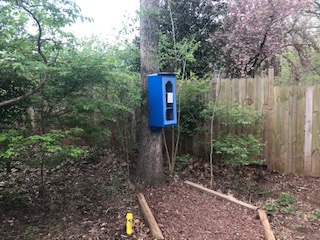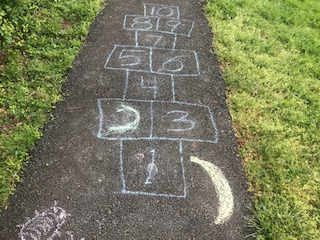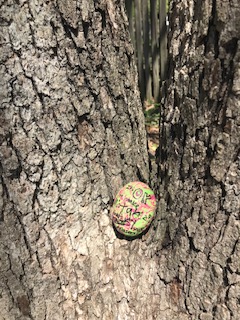“All architecture is what you do to it when you look at it,
(Did you think it was in the white or gray stone? Or the lines of the arches and cornices?)” Walt Whitman
I’ve never thought what to call it. This delightful little stretch along one of my favorite suburban hikes in the woods in my neighborhood. “Fairy Land?” “Minnie Ville?” Whatever name you choose, it sure has gotten my full attention. And it brings a smile to face every time, and curiously an intrinsic urge to want to wave back at the gnomes and elves and other wee folk facing my direction.

These wee little folk come in all kinds of fanciful positions; one industrious dwarf carries an armload of sticks while another is hauling little gems with a wheelbarrow.

It’s nothing fancy. Its features weren’t sponsored by some corporate partnership. They don’t have to have historic meaning that is indigenous to the local area.
All of these delightful creatures owe their existence on this particular footpath because some kindly, imaginative soul was daydreaming some time ago and decided to just do it because it made him or her happy. No doubt, this original dreamer will enlist their entire family into adding and on their own little touches and make the village expand.
And by the time I have passed through this little kingdom, I feel as filled up and delighted as if I had paid for a Disney ride.
It’s as if I took a trolley ride with Mr. Rogers to the land of make believe!
All this got me wondering about what truly constitutes a landmark and how simple it can really be to make a difference in terms of one’s cultural geography.

Such aesthetic diversions take many forms out in public. It might be the spontaneous appearance of seeing some local lender library stations placed in strategic placed by some generous philanthropist.
Or it might be something more whimsical and temporary—like chalk art on the sidewalk done by a group of quarantined children.

Or it could be the companionship of seeing a staggered assortment of peace stones tucked strategically away on tree stumps or sidewalk curves reminding us that somebody else took time to care.

Above peace stone says, “It’s OK to make mistakes, that’s why we have erasers!!”
Such etchings out in the community serve to edify and send ripple effects of memories and untold happy moments. They can provide additional meaning on top of what is already there in the first place.
As tangible sequences on our voyage, they connect us as much to our surroundings as the signs that tell us the elevation of the ground or that the tributary we are passing over belongs to the Chesapeake Bay Watershed.
When you think of it, a lot of what constitutes our mental maps when we reminisce on where we’ve been by car or on foot, is composed of fanciful, subjective details of scenery such as peace stones or lawn ornaments.
And, when done harmoniously, such expressions won’t negatively impact the environment, like graffiti carved into the trunk of a Beech Tree.
It will only enhance it.
Of course, in most cases, we will never get to show our appreciation directly to the authors of these simple acts of generous creativity, but we can certainly acknowledge, inside our own thoughts, what a pleasant, uplifting contribution they make.
And that’s a big reason why maps are so fascinating and fun in the first place. Everybody’s mental maps are filled with varying degrees of fiction and non-fiction for inspiration. Some folks walk right past trees and stone and just see blank wood and blank rock, while others visualize sculptures and poetry.
Such simple pleasures become remembered long after the memory of the street names and addresses fade away.
And now is the best time to take note and expand our own mental maps.
So, let’s put away our electronic lifelines long enough to be observant and scan high and low when we walk. Since we are now being forced to slow down, we might as well come to our senses. If our sense of touch and our closeness to other people is temporarily removed—we should overcompensate and celebrate our closeness to nature!
